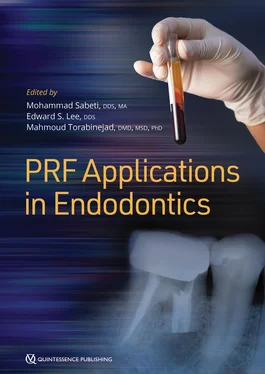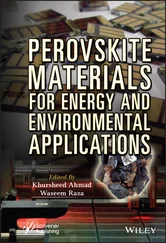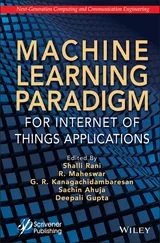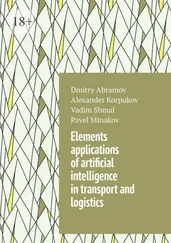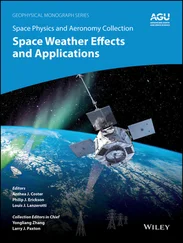PRF Applications in Endodontics
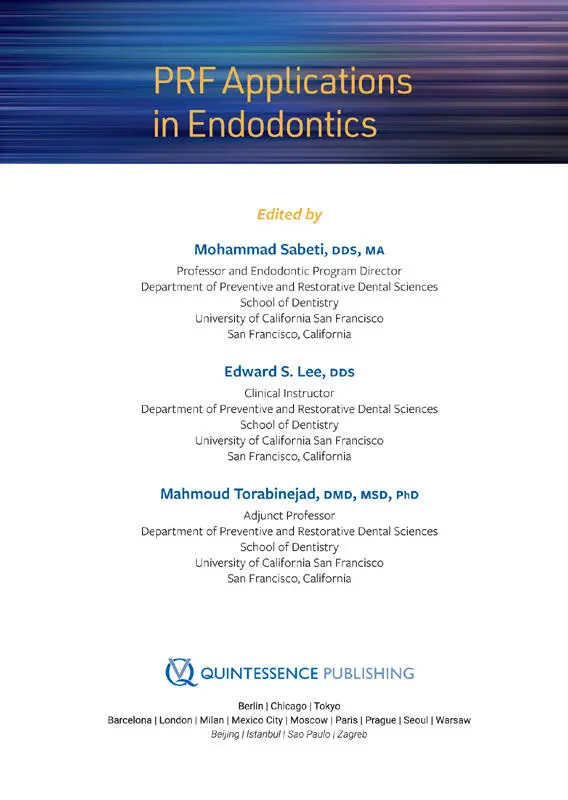
Library of Congress Cataloging-in-Publication Data
Names: Sabeti, Mohammad (Mike) A., editor. | Lee, Edward S., editor. Torabinejad, Mahmoud, editor.
Title: PRF applications in endodontics / edited by Mohammad Sabeti, Edward S. Lee, Mahmoud Torabinejad.
Description: Batavia, IL : Quintessence Publishing Co., Inc., [2020] Includes bibliographical references and index. | Summary: “This handbook will help clinicians understand and use PRF in endodontics by discussing the science, clinical applications, and techniques for specialists and general practitioners”-- Provided by publisher.
Identifiers: LCCN 2020002529 (print) | LCCN 2020002530 (ebook) | ISBN 9780867158274 (paperback) | ISBN 9781647240196 (epub)
Subjects: MESH: Dental Materials--chemical synthesis | Platelet-Rich Fibrin Regenerative Endodontics methods
Classification: LCC RK652.5 (print) | LCC RK652.5 (ebook) | NLM WU 190 DDC 617.6/95--dc23
LC record available at https://lccn.loc.gov/2020002529
LC ebook record available at https://lccn.loc.gov/2020002530

©2020 Quintessence Publishing Co, Inc
Quintessence Publishing Co, Inc
411 N Raddant Road
Batavia, IL 60510
www.quintpub.com
All rights reserved. This book or any part thereof may not be reproduced, stored in a retrieval system, or transmitted in any form or by any means, electronic, mechanical, photocopying, or otherwise, without prior written permission of the publisher.
Editor: Marieke Zaffron
Editorial Assistant: Samantha Smith
Design: Sue Zubek
Production: Sue Robinson
I dedicate this book to my wife, Parvin, and my children, Sara and Ali, with love.
–MS
I would like to thank my mentors, Dr Ronald J. Nicholson and Dr Chutima Mangkornkarn for inspiring me to become a better clinician and person, and to Dr Calvin Tae Nam for sharing his knowledge about PRF.
–ESL
To the soul of my dear father whom we lost to cancer early in his and our lives.
–MT
Foreword by Richard J. Miron
Preface
Contributors
Introduction by Mahmoud Torabinejad
1 Stem Cells in Regenerative Medicine
C. Cameron Taylor | Habib Torfi | Mohammad Sabeti
2 History, Science, Armamentarium, and How to Make PRF
Edward S. Lee
3 Nonsurgical Application: PRF for Regeneration Endodontics
Mohammad Sabeti | Edward S. Lee
4 Soft Tissue Applications
Kayvon Javid | Gregori M. Kurtzman | Carlos Fernando Mourão
5 Hard Tissue Applications
Kayvon Javid | Gregori M. Kurtzman | Carlos Fernando Mourão
6 PRF in Endodontic Surgery
Mohammad Sabeti | Gregori M. Kurtzman Edward S. Lee | Eric Wong
7 PRF for Socket Preservation
Yogalakshmi Rajendran | Yvonne Kapila
Index
The use of platelet-rich fibrin (PRF) has seen a rapid increase over the past decade, owing to its ability to rapidly release autologous growth factors harvested quite easily from peripheral blood. While original case studies dating back nearly two decades focused primarily on its use in medicine for the treatment of hard-to-heal wound ulcers, it is now well known that its inclusion of high concentrations of platelets and leukocytes has served several benefits in dentistry. Specifically, platelets are largely responsible for the release of various regenerative growth factors favoring wound healing, whereas leukocytes (white blood cells) participate in host defense against incoming pathogens. The ability to concentrate both cell types found within PRF has shown pronounced benefits in the oral cavity, an area particularly concentrated with various oral bacteria.
Over the years, several research articles focused on the use of PRF for multiple applications in regenerative dentistry; more recently, publications have begun to emerge dealing specifically with its use in endodontics. I have the great pleasure to announce the launch of this new book, PRF Applications in Endodontics , which addresses this topic in extensive detail.
The book begins by providing background knowledge on various cell types found in regenerative medicine with particular focus on stem cells. Thereafter, the book rapidly enters into a variety of chapters dedicated to PRF with a brief history regarding its scientific background, including growth factors, armamentarium, and protocols utilized to fabricate PRF. The discussion then transitions to nonsurgical applications in regenerative endodontics, as well as its use in dentistry, particularly for the formation of a bone grafting material complex including bone grafting particles and autologous PRF (aka “sticky bone”). Its use as an alternative to bone grafts and other biomaterials is further discussed in later chapters dealing with endodontic surgery. These include various endodontic procedures indicated following common human “accidents” (accidental tooth loss and replantation, for instance), for improvements in furcation-involved teeth as a result of iatrogenic procedures, for root-end resection procedures, and for the management of surgical cysts.
This textbook is for both the beginner as well as the advanced endodontist and practicing dentist working in the field of endodontics wishing to further improve their practice by adopting some of the latest regenerative protocols. It is certainly a first of its kind and a must-read in the field of endodontics, highlighting the benefits of autologous blood concentrates specifically dedicated to endodontic procedures.
Colleagues will certainly enjoy this read, and it will undoubtedly open many avenues of future research on the topic!
Richard J. Miron, DDS, MSc, PhD
Group Leader, The Miron Research Lab
Lead Educator, Advanced PRF Education
Venice, Florida
As endodontists and periodontists, we are all familiar with the potential applications of platelet-rich plasma (PRP) in medicine and dentistry. But in the past few years, platelet-rich fibrin (PRF) has emerged as an alternative material in its own right. One of our first opportunities to observe the effects of PRF was in discussion with colleagues using it in oral surgery procedures. Their patients experienced remarkable hard and soft tissue healing with minimal postoperative discomfort. Intrigued, we dug further and discovered the widespread applications of PRF in dentistry and medicine.
The appeal of PRF stems from the fact that it is made from a patient’s own blood. It is easy to prepare and can be used for many kinds of procedures, making it cost-effective. PRF has many potential applications in endodontics. It can be used in surgical endodontics and adjunctive surgical procedures such as root amputation and hemisection. In addition, it can be used for root perforation repair, vital pulp therapy, and regenerative endodontics. Furthermore, it can be used as a bone graft binder during socket preservation to create “sticky bone” for the closure of surgical sites.
When the three of us first met, the idea of sharing these various applications of PRF was an immediate common ground. We were working with residents at the time and knew how much they could benefit from learning about PRF. After using PRF and observing successful outcomes in several cases, we decided to take things to the next level. We brought together some of the most forward-thinking endodontists, periodontists, oral surgeons, and general practitioners to share our thoughts regarding potential use of this material in endodontics and other fields of dentistry.
Читать дальше
